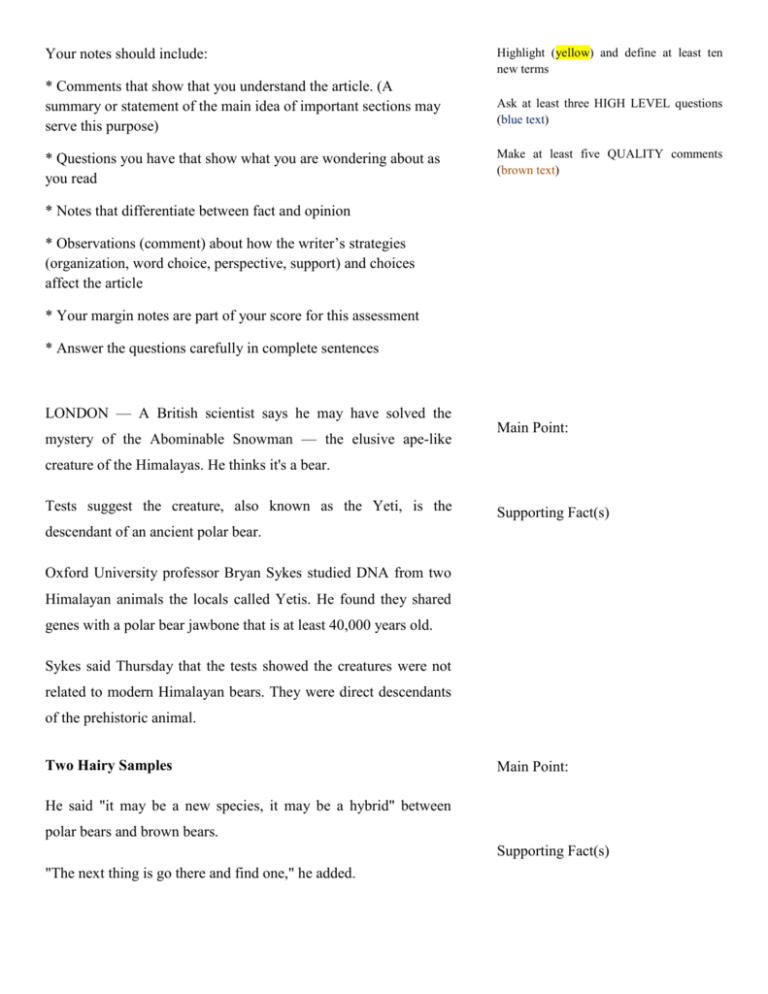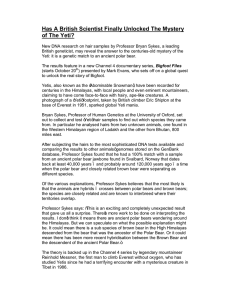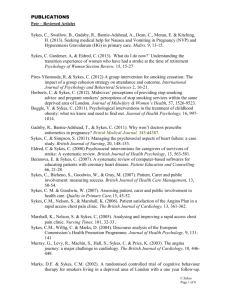AOW: Yeti DNA
advertisement

Your notes should include: * Comments that show that you understand the article. (A summary or statement of the main idea of important sections may serve this purpose) * Questions you have that show what you are wondering about as you read Highlight (yellow) and define at least ten new terms Ask at least three HIGH LEVEL questions (blue text) Make at least five QUALITY comments (brown text) * Notes that differentiate between fact and opinion * Observations (comment) about how the writer’s strategies (organization, word choice, perspective, support) and choices affect the article * Your margin notes are part of your score for this assessment * Answer the questions carefully in complete sentences LONDON — A British scientist says he may have solved the mystery of the Abominable Snowman — the elusive ape-like Main Point: creature of the Himalayas. He thinks it's a bear. Tests suggest the creature, also known as the Yeti, is the Supporting Fact(s) descendant of an ancient polar bear. Oxford University professor Bryan Sykes studied DNA from two Himalayan animals the locals called Yetis. He found they shared genes with a polar bear jawbone that is at least 40,000 years old. Sykes said Thursday that the tests showed the creatures were not related to modern Himalayan bears. They were direct descendants of the prehistoric animal. Two Hairy Samples Main Point: He said "it may be a new species, it may be a hybrid" between polar bears and brown bears. Supporting Fact(s) "The next thing is go there and find one," he added. Sykes asked museums, scientists and Yeti aficionados to share hair samples thought to be from the creature. One of the samples he analyzed came from an alleged Yeti mummy in the Indian region of Ladakh, at the Western edge of the Himalayas. It was taken by a French mountaineer who was shown the corpse 40 years ago. The other was a single hair found a decade ago in Bhutan, 800 miles (1,300 kilometers) to the east. Now To Find The Creature Main Point: Sykes said finding the hairs so recently and so far apart suggests the members of the species are still alive. "I can't imagine we managed to get samples from the only two 'snow bears' in the Himalayas," he said. Finding a living creature could explain the descriptions of the Yeti. The polar bear genes could make them act and look different and walk on two feet more often, he said. Sykes' research has not been published, but he says he has submitted it for peer review. It is a reasonable explanation for the Yeti stories, said professor Tom Gilbert of the Natural History Museum of Denmark. "It's a lot easier to believe that than if he had found something else," said Gilbert, who was not involved in the study. "If he had said it's some kind of new primate, I'd want to see all the data." Sykes' findings are unlikely to lay the myth of the Yeti to rest. Supporting Fact(s) The Stuff Of Legends Main Point: The Yeti, or Abominable Snowman, is one of a number of legends about beasts, such as Sasquatch and Bigfoot. Decades of eyewitness reports, blurry photos and stories have kept the legend alive. But scientists doubt it. "I do not think the study gives any comfort to Yeti-believers," David Frayer, a professor of biological anthropology at the University of Kansas, said in an email. But "no amount of scientific data will ever shake their belief." If Sykes wanted "to refute the Yeti nonsense, then good luck," he said. Sykes said he was simply trying "to inject some science into a rather murky field." "The Yeti, the Bigfoot, is surrounded in myth and hoaxes," he said. "But you can't invent a DNA sequence from a hair." Writer’s Craft Identify the Author’s Purpose for writing this article Who is the intended audience? Explain Annotate- Specify the Main Points of the article, along with supporting details/ facts. Look for transitions! Summarize the article in 9- 14 sentences Supporting Fact(s)












